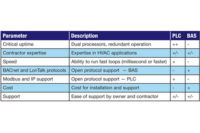On several recent projects, we have had control contractors who have promoted the use of pressure-independent control valves (PICV). This has led to some interesting discussions about the costs and benefits of these valves.
The original concept of a PICV was basically a single casting that included both a control valve (generally a ball valve) along with a pressure regulator for flow control. In effect, it was a balancing valve and control valve in a single package. More recently, suppliers are starting to offer more sophisticated solutions that include logic as part of the valve assembly along with a control valve, flow meter, and optional temperature sensors. These electronic PICVs may be more cost-effective for larger sizes and offer additional benefits in terms of monitoring and control.
The concept of pressure-independent control is that you should be able to have the same amount of flow through a device regardless of the inlet pressure. For example, a pressure-independent VAV box controller operates by resetting the flow setpoint in response to zone temperature. The box flow is controlled regardless of any variation in the incoming air pressure. The anticipated result is more stable control, plus improved feedback on system operation.
The suppliers of PICVs claim numerous benefits resulting from the use of these valves. Potential benefits include:
• Improved control stability — for example, the discharge air temperature of an air handler should be more stable.
• Reduced system pumping energy due to reduced overflow of the coil.
• Improved chiller and boiler efficiency by having the system run at the design Delta T.
• Cost reduction due to fewer devices.
• Improved visibility to the operator about the operation of the valve and coil.
All of these could definitely be beneficial. However, the more critical question is whether the benefits are worth the added costs. We have been focusing on the use of either mechanical or electronic pressure independent valves for large air handlers. There is definitely a cost premium to the use of these valves; on a recent project, the cost of the valve with installation was two to three times that of a globe valve. The question then becomes is it worth it?
To determine this, we ran a version of our energy model using a plug in to simulate the PICV. After several runs, we did find that there were benefits in terms of reduced system pumping, resulting in a simple payback on the premium for the valves of a few years. Given the other potential benefits (including improved discharge control, better operator feedback, and the potential for Btu metering at the coil), it seemed worth considering.
We would encourage readers to keep an open mind and carefully consider the use of PICVs for your next project.




